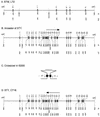Inversions over the terminus region in Salmonella and Escherichia coli: IS200s as the sites of homologous recombination inverting the chromosome of Salmonella enterica serovar typhi
- PMID: 12399489
- PMCID: PMC151944
- DOI: 10.1128/JB.184.22.6190-6197.2002
Inversions over the terminus region in Salmonella and Escherichia coli: IS200s as the sites of homologous recombination inverting the chromosome of Salmonella enterica serovar typhi
Abstract
Genomic rearrangements (duplications and inversions) in enteric bacteria such as Salmonella enterica serovar Typhimurium LT2 and Escherichia coli K12 are frequent (10(-3) to 10(-5)) in culture, but in wild-type strains these genomic rearrangements seldom survive. However, inversions commonly survive in the terminus of replication (TER) region, where bidirectional DNA replication terminates; nucleotide sequences from S. enterica serovar Typhimurium LT2, S. enterica serovar Typhi CT18, E. coli K12, and E. coli O157:H7 revealed genomic inversions spanning the TER region. Assuming that S. enterica serovar Typhimurium LT2 represents the ancestral genome structure, we found an inversion of 556 kb in serovar Typhi CT18 between two of the 25 IS200 elements and an inversion of about 700 kb in E. coli K12 and E. coli O157:H7. In addition, there is another inversion of 500 kb in E. coli O157:H7 compared with E. coli K12. PCR analysis confirmed that all S. enterica serovar Typhi strains tested, but not strains of other Salmonella serovars, have an inversion at the exact site of the IS200 insertions. We conclude that inversions of the TER region survive because they do not significantly change replication balance or because they are part of the compensating mechanisms to regain chromosome balance after it is disrupted by insertions, deletions, or other inversions.
Figures



References
-
- Anderson, R. P., and J. R. Roth. 1978. Tandem chromosomal duplications in Salmonella typhimurium: fusion of histidine genes to novel promoters. J. Mol. Biol. 119:147-166. - PubMed
-
- Beltran, P., S. A. Plock, N. H. Smith, T. S. Whittam, D. C. Old, and R. K. Selander. 1991. Reference collection of strains of the Salmonella typhimurium complex from natural populations. J. Gen. Microbiol. 137:601-606. - PubMed
Publication types
MeSH terms
Substances
Grants and funding
LinkOut - more resources
Full Text Sources

